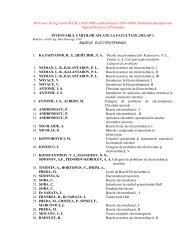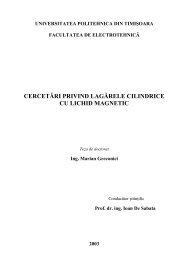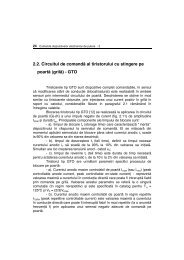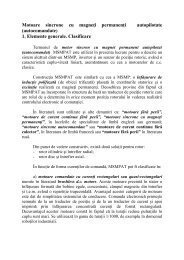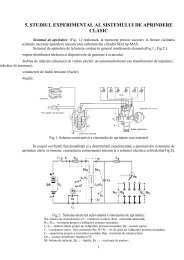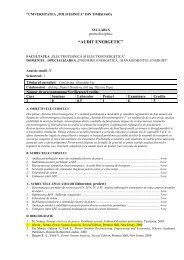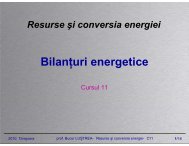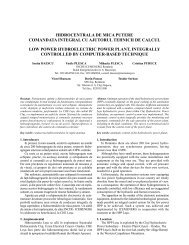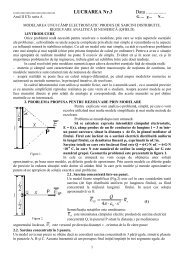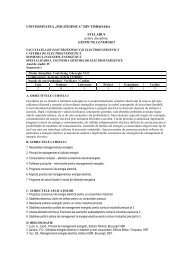Power Generation Limits Assessment of a Multimachine Power ...
Power Generation Limits Assessment of a Multimachine Power ...
Power Generation Limits Assessment of a Multimachine Power ...
You also want an ePaper? Increase the reach of your titles
YUMPU automatically turns print PDFs into web optimized ePapers that Google loves.
EVALUAREA LIMITELOR PUTERII GENERATE PENTRU O REŢEA<br />
ELECTRICĂ DE TRANSPORT A ENERGIEI CU MAI MULTE MAŞINI<br />
FOLOSIND O METODĂ HIBRIDĂ DE APRECIERE A STABILITĂŢII<br />
TRANZITORII<br />
POWER GENERATION LIMITS ASSESSMENT OF A MULTIMACHINE<br />
POWER NETWORK USING A HYBRID TRANSIENT STABILITY<br />
METHOD<br />
C. M. Machado FERREIRA J. A. Dias PINTO<br />
Departamento de Engenharia Electrotécnica<br />
Instituto Superior de Engenharia de Coimbra , Rua Pedro Nunes, 3030-199 Coimbra, PORTUGAL<br />
Tel: +351 239 790 200, Fax: +351 239 790 270<br />
cmacfer@ieee.org j.pinto@ieee.org<br />
F. P. Maciel BARBOSA<br />
Departamento de Engenharia Electrotécnica e de Computadores<br />
Faculdade de Engenharia da Universidade do Porto, R. Dr. Roberto Frias, 4200-465 Porto, PORTUGAL<br />
Tel.: +351 225 081 874, Fax.: +351 225 081 443<br />
fmb@fe.up.pt<br />
Rezumat: În acest articol se prezintă o metodologie de evaluare<br />
a limitelor puterii generate într-o reţea de transport a energiei<br />
cu mai multe maşini, care este bazată pe o metodă hibridă de<br />
apreciere a stabilităţii tranzitorii. Această abordare eficientă şi<br />
robustă combină avantajele schemelor de integrare în domeniul<br />
timpului pentru a calcula traiectoria iniţială a sistemului cu<br />
criteriul suprafeţelor egale. Formularea dezvoltată foloseşte<br />
precizia de modelare a tehnicilor de simulare în domeniul timpului<br />
laolaltă cu viteza de calcul şi informaţia bogată produsă de abordarea<br />
directă. În această formulare hibridă reţeaua de transport a<br />
energiei cu mai multe generatoare este redusă la o singură<br />
maşină conectată la o bară de putere infinită. Aprecierea stabilităţii<br />
tranzitorii este realizată cu ajutorului indicatorilor de stabilitate şi<br />
în consecinţă simularea în domeniul timpului este calculată numai<br />
pentru o scurtă perioadă de integrare. O procedură de terminare<br />
timpurie reduce drastic timpul de calcul. Algoritmul propus este<br />
aplicat diferitelor reţele test de transport a energiei şi rezultatele<br />
sunt comparate cu soluţiile obţinute pe o altă cale de abordare.<br />
Keywords: Simularea dinamică a sistemelor de putere, Formularea<br />
hibridă a stabilităţii tranzitorii, Limitele puterii generate (limite<br />
de stabilitate)<br />
1. Introducere<br />
În ultimii ani, sistemele de putere (SP) sunt confruntate<br />
cu noi provocări datorate strategiei de dereglementare a<br />
pieţei de electricitate [1], care introduce noi oportunităţi<br />
pentru competiţie [2]. Aceasta pune o varietate de probleme<br />
complexe în scopul de a menţine o alimentare economică<br />
şi fiabilă cu electricitate ţinând cont de mediul înconjurător<br />
ca şi de constrângerile financiare şi de reglaj [3]. De altfel,<br />
SP moderne au crescut continuu în complexitate datorită<br />
noilor linii de interconexiune şi folosirii noilor tehnologii.<br />
Prin urmare, serviciile publice au fost forţate să exploateze<br />
reţelele lor de transport la capacitatea maximă a lor şi foarte<br />
apropiat de limitele lor maxime [4]. În consecinţă, se<br />
lucrează cu limite de stabilitate restrânse. Aceasta pune în<br />
Abstract: In this paper it is presented a methodology to assess<br />
the power generation limits <strong>of</strong> a multimachine power network<br />
based on a hybrid transient stability method. This efficient and<br />
robust approach combines the advantages <strong>of</strong> the time domain<br />
integration schemes to compute the initial system trajectory with<br />
the equal area criterion. The developed formulation uses the<br />
modeling accuracy <strong>of</strong> the time domain simulation techniques<br />
with the computing speed and large information produced by the<br />
direct approach. In this hybrid formulation the multimachine power<br />
network is reduced to a one machine connected to an infinite<br />
busbar. The transient stability assessment is performed using<br />
stability indices and consequently the time domain simulation is<br />
only computed during a short integration period. This early<br />
termination procedure reduces drastically the computing time.<br />
The proposed algorithm is applied to different test power<br />
networks and the results are compared with the solutions<br />
produced by another formulation.<br />
Keywords: <strong>Power</strong> Systems Dynamic Simulation, Transient Stability<br />
Hybrid Formulation, <strong>Power</strong> <strong>Generation</strong> <strong>Limits</strong><br />
1. Introduction<br />
In the last years, Electric <strong>Power</strong> Systems (EPS) have<br />
faced new challenges due to the deregulation strategy <strong>of</strong><br />
the electricity market [1], introducing a new opportunity for<br />
competition [2]. This poses a variety <strong>of</strong> complex problems in<br />
order to maintain an economical and reliable supply <strong>of</strong><br />
electricity taking into account environment and technical<br />
as well as financial and regulatory constraints [3]. Moreover,<br />
modern EPS are continually increasing in complexity due to<br />
new interconnection tie-lines and the use <strong>of</strong> new technologies.<br />
Therefore, electric utilities are being forced to operate their<br />
power networks at their maximum capacity and closer to<br />
their transmission limits [4]. Consequently, operate with<br />
restricted stability margins. This poses a variety <strong>of</strong> new
234<br />
stadiile de planificare, la fel ca şi pe durata funcţionării<br />
sistemului, o mare diversitate de noi probleme inginereşti.<br />
Unul din cele mai importante studii pentru planificarea,<br />
proiectarea, funcţionarea şi reglarea unui sistem complex<br />
de putere este evaluarea stabilităţii tranzitorii [5]. Această<br />
analiză cuprinde evaluarea capacităţii unui SP de a rezista<br />
la mari perturbaţii şi de a supravieţui trecerii spre condiţii<br />
normale sau acceptabile de funcţionare [6]. Studiile convenţionale<br />
de stabilitate tranzitorie sunt realizate în mod<br />
normal pe o bază deterministă, care se bizuie pe abordarea<br />
“celui mai rău caz”. În mod uzual se simulează un defect<br />
trifazat pe anumite bare din sistem, care apare când cererea<br />
sarcinii are valoarea de vârf pe un interval de timp specificat.<br />
Securitatea reţelei de transport a energiei este evaluată pe<br />
cale numerică, rezolvând ecuaţiile diferenţiale de mişcare<br />
ale sistemului şi analizând curbele de oscilaţie care rezultă<br />
pentru maşinile ei sincrone [7]. Într-un mediu competitiv,<br />
această strategie nu mai este acceptabilă, pentru că serviciile<br />
publice vor trebui să ştie nivelul de risc asociat cu criteriul<br />
observat al lor în scopul de a ajusta calitatea bazată pe<br />
aşteptarea consumatorilor şi cerinţele pieţei [8].<br />
Cu toate că programele de simulare în domeniul timpului<br />
pot mânui orice modelare detailată a reţelei de transport a<br />
energiei, ele necesită un timp de calcul mare şi sunt<br />
incapabile să aprecieze gradul de stabilite a sistemului.<br />
Pentru a reduce timpul mare de calcul pe care această<br />
abordare îl cere şi pentru a obţine mai multe informaţii<br />
referitoare la siguranţa sistemului, în ultimii ani au fost<br />
realizate o serie de cercetări referitoare la aplicarea<br />
metodelor directe şi hibride de apreciere a stabilităţii<br />
tranzitorii [9], [10].<br />
În acest articol se prezintă o metodologie bazată pe<br />
metoda hibridă de apreciere a stabilităţii, pentru evaluarea<br />
limitelor de generare a puterii unei reţele multi-maşină de<br />
transport a energiei. Această metodologie robustă şi eficientă<br />
combină avantajele schemelor de integrare în domeniul<br />
timpului pentru calculul traiectoriei iniţiale a sistemului<br />
cu criteriul ariilor egale. Formularea dezvoltată foloseşte<br />
acurateţea de modelare specifică tehnicilor de simulare în<br />
domeniul timpului laolaltă cu viteza de calcul şi informaţia<br />
bogată produsă prin abordarea directă. În această formulare<br />
hibridă reţeaua de transport a energiei cu mai multe maşini<br />
este redusă la o singură maşină conectată la o bară de putere<br />
infinită. Aprecierea stabilităţii tranzitorii este obţinută<br />
folosind indicatori de stabilitate şi în consecinţă simularea<br />
în domeniul timpului este calculată numai pentru o perioadă<br />
scurtă de integrare. O procedură de terminare timpurie<br />
reduce drastic timpul de calcul. Limitele de stabilitate<br />
tranzitorie sunt calculate aplicând criteriul suprafeţelor<br />
egale la sistemul redus echivalent.<br />
Programul de calcul dezvoltat de autori a fost integrat<br />
în pachetul de programe TRANsySTEM. În scopul de a<br />
valida modelele matematice stabilite, la fel ca şi pachetul<br />
de programe, a fost studiată stabilitatea tranzitorie a trei<br />
reţele test de transport a energiei: sistemul cu 3 maşini şi<br />
9 bare [11]; sistemul cu 7 maşini şi 10 bare [12]; sistemul<br />
test IEEE cu 17 noduri [13] (numai acela este prezentat în<br />
expunere) Rezultatele obţinute cu formularea hibridă au<br />
fost comparate cu soluţiile produse de un program de simulare<br />
în domeniul timpului. În final sunt scoase în evidenţă<br />
câteva concluzii care <strong>of</strong>eră o contribuţie valoroasă pentru<br />
înţelegerea analizei stabilităţii tranzitorii a SP.<br />
The 5 th International <strong>Power</strong> Systems Conference<br />
engineering problems at the planning and design stages as<br />
well as during the system operation.<br />
One <strong>of</strong> the most important studies in the planning, design,<br />
operation and control <strong>of</strong> a multimachine power system is<br />
the transient stability assessment [5]. This analysis entails<br />
the evaluation <strong>of</strong> an electric power system ability to withstand<br />
large disturbances and to survive transition to a normal or<br />
acceptable operating condition [6]. Conventional transient<br />
stability studies are normally performed in a deterministic<br />
basis, which relies upon a “worst case” approach. It is usually<br />
simulated a three-phase fault at particular system busbars,<br />
occurring when the load demand reaches its peak value over<br />
the specified time interval. The electric power network<br />
security is assessed by numerically solving the differential<br />
motion equations <strong>of</strong> the system and analyzing the resulting<br />
swing curves <strong>of</strong> its synchronous machines [7]. In a competitive<br />
environment this strategy is no longer acceptable,<br />
since the utilities will need to know the risk level associated<br />
with their observed criteria in order to adjust their quality<br />
service based on consumer’s expectation and market<br />
requirements [8].<br />
Although the time domain simulation programs may<br />
handle any detailed power network modeling, they require<br />
large computing time and are unable to appraise the degree<br />
<strong>of</strong> system stability. In order to reduce the large CPU time<br />
that these approaches require and to obtain more information<br />
related to the system security, several developments have<br />
been performed in the last years to apply direct and hybrid<br />
methods in the transient stability assessment [9], [10].<br />
In this paper it is presented a methodology to evaluate<br />
the power generation limits <strong>of</strong> a multimachine power<br />
network based on a hybrid transient stability method. This<br />
efficient and robust approach combines the advantages <strong>of</strong><br />
the time domain integration schemes to compute the initial<br />
system trajectory with the equal area criterion. The developed<br />
formulation uses the modeling accuracy <strong>of</strong> the time domain<br />
simulation techniques with the computing speed and large<br />
information produced by the direct approach. In this hybrid<br />
formulation the multimachine power network is reduced<br />
to a one machine connected to an infinite busbar. The<br />
transient stability assessment is obtained using stability<br />
indices and consequently the time domain simulation is<br />
only computed during a short integration period. This<br />
early termination procedure reduces drastically the<br />
computing time. The transient stability margins are<br />
calculated applying the equal area criterion to the<br />
equivalent reduced system.<br />
The computer programs developed by the authors<br />
were integrated in the s<strong>of</strong>tware package TRANsySTEM.<br />
In order to validate the established mathematical models<br />
as well as the s<strong>of</strong>tware package it was studied the transient<br />
stability <strong>of</strong> three different test power networks: 3 machines<br />
9 busbar system [11]; 7 machines 10 busbar system [12];<br />
the IEEE 17 synchronous machines test power system<br />
[13] (the only one presented in the extended summary).<br />
The results obtained with the hybrid formulation were<br />
compared with the solutions produced by a time domain<br />
simulation program. Finally, some conclusions that<br />
provide a valuable contribution to the understanding <strong>of</strong> a<br />
multimachine power systems transient stability analysis<br />
are pointed out.
06-07.11.2003, Timişoara, Romania 235<br />
2. Formularea problemei<br />
Abordarea hibridă a stabilităţii tranzitorii reduce sistemul<br />
cu mai multe maşini la O Maşină echivalentă conectată la o<br />
Bară de putere Infinită (OMBI=OMIB în engleză). Aceasta<br />
se realizează presupunând că atunci când apare o contingenţă,<br />
SP este divizat în grupul celor mai perturbate maşini sincrone<br />
şi restul sistemului Grupul critic este ales din cele mai critice<br />
mulţimi. Pentru a preciza maşinile sincrone care aparţin<br />
acestor grupări se aplică un criteriu de selecţie bazat pe<br />
rangul critic al maşinii [15] şi în acceleraţii este aplicată<br />
puterea. În ultimul caz, maşinile critice sunt identificate a<br />
fi acelea cu cea mai mare accelerare obţinută din simulările<br />
în domeniul timp în momentul deconectării.<br />
Trebuie realizată o schemă de integrare în domeniul<br />
timpului pentru a evalua traiectoria sistemului şi parametrii<br />
dinamici. Din aceste valori, obţinute la fiecare pas de<br />
integrare vor fi trasate curbele OMBI. Aplicând criteriul<br />
suprafeţelor egale se obţine limita de stabilitate tranzitorie.<br />
Timpul critic de deconectare este evaluat utilizând o tehnică<br />
de interpolare sau extrapolare bazată pe limitele de stabilitate<br />
tranzitorie obţinute prin simulări succesive (în mod obişnuit<br />
două sau trei).<br />
În abordarea hibridă a fost de asemenea incorporat un<br />
criteriu de oprire pentru a furniza terminarea automată şi timpurie<br />
a simulărilor, imediat ce este detectată (in)stabilitatea<br />
post varie. Terminarea timpurie a algoritmului evaluează<br />
stabilitatea tranzitorie a reţelei complexe de transport a energiei<br />
pe baza conceptului de produs scalar preluat din metoda<br />
Suprafeţei Limită a Energiei Potenţiale (SLEP=PEBS în<br />
engleză) [16]. În această analiză, este verificată traiectoria<br />
post avarie până când ea străbate sau nu străbate SLEP. Dacă<br />
defectul este înlăturat după Timpul critic de Deconectare<br />
(TCD=CCT în engleză), traiectoria este instabilă şi va<br />
străbate SLEP. Dacă defectul este înlăturat înainte de TCD,<br />
atunci traiectoria este stabilă şi nu va străbate SLEP.<br />
Primul Produs Scalar (PS1=DP1 în engleză) indică<br />
faptul dacă traiectoria post avarie străbate SLEP. Al doilea<br />
Produs Scalar (PS2=DP2 în engleză) indică faptul dacă<br />
traiectoria post avarie se reîntoarce înainte de a intersecta<br />
SLEP (sistemul este stabil la prima oscilaţie). Pentru un<br />
caz stabil, sistemul nu trebuie să-şi piardă sincronismul,<br />
unghiul şi viteza tuturor generatoarele trebuie să aibă<br />
valori apropiate de COA şi deci trebuie să fie sub o anumită<br />
valoare [17]. Pentru un caz instabil, unghiul generatorului<br />
critic se va separa de unghiurile celorlalte generatoare şi<br />
va creşte de-a lungul traiectoriei. Astfel, pe durata procesului<br />
de integrare dacă PS1 îşi schimbă semnul înaintea lui PS2,<br />
atunci simularea este oprită şi sistemul este presupus instabil.<br />
Dacă PS2 îşi schimbă semnul înaintea lui PS1 simularea<br />
estre încheiată şi sistemul este presupus a fi stabil la prima<br />
oscilaţie [18].<br />
În scopul de îmbunătăţi precizia şi siguranţa metodologiei<br />
propuse, au fost utilizaţi de asemenea trei indici auxiliari.<br />
Primi doi indici AI1 şi AI2 sunt folosiţi pentru a testa când<br />
produsele (PS1 şi PS2) îşi schimbă semnul. Al treilea este<br />
Deviaţia Maximă a Unghiului (DMU=MAD în engleză)<br />
şi este folosit pe durata perioadei defectului pentru a detecta<br />
cazurile severe de instabilitate şi a opri simularea în domeniul<br />
timpului cât mai curând când aceste situaţii apar.<br />
Limitele de stabilitate sunt evaluate folosind o tehnică<br />
de interpolare sau extrapolare combinată cu coeficienţi de<br />
sensibilitate. În scopul de a menţine siguranţa SP şi de a<br />
2. Formulation <strong>of</strong> the problem<br />
The hybrid transient stability approach reduces the<br />
multimachine system to one equivalent machine connected<br />
to an infinite busbar (OMIB) [14]. This is performed<br />
assuming that when a contingency occurs the power<br />
system is split into the cluster <strong>of</strong> the most disturbed<br />
synchronous machines and the remaining subsystem. The<br />
critical cluster is chosen from the most critical sets. To<br />
specify the synchronous machines <strong>of</strong> these clusters a<br />
selection criteria based on the critical machine ranking<br />
[15] and in the accelerations power will be applied. In the<br />
last case the critical machines are identified to be the ones<br />
with largest acceleration obtained from the time domain<br />
simulation, at the fault clearing time.<br />
A time domain integration scheme should be carried<br />
out in order to evaluate the system trajectory and the<br />
dynamic parameters. From these values, obtained in every<br />
integration step the OMIB curves will be plotted.<br />
Applying the equal area criterion the transient stability<br />
margin is obtained. The critical clearing time is evaluated<br />
using an interpolation or extrapolation technique based on<br />
the values <strong>of</strong> the transient stability margins obtained by<br />
successive simulations (usually two or three).<br />
It was also incorporated in the hybrid approach a stop<br />
criterion to provide automatic and early termination <strong>of</strong> the<br />
simulations as soon as post-fault (un)stability are detected.<br />
The early termination algorithm assess the transient<br />
stability <strong>of</strong> the multimachine power network based on the<br />
concept <strong>of</strong> the dot products from the Potential Energy<br />
Boundary Surface method (PEBS) [16]. In this analysis<br />
the post-fault trajectory is checked whether it passes the<br />
PEBS or not. If the fault is cleared after the critical clearing<br />
time CCT, the trajectory is unstable and will cross the<br />
PEBS. If the fault is cleared before the CCT, the trajectory<br />
is stable and will not cross the PEBS.<br />
The first dot product DP1 indicates that the post-fault<br />
trajectory crosses the PEBS. The second dot product DP2<br />
indicates that the post-fault trajectory swings back before<br />
it crosses the PEBS (the system is first-swing stable). For<br />
a stable case, the system does not lose synchronism, the<br />
angle and speed <strong>of</strong> all generators should be the values close<br />
to COA, and hence should be within some value [17]. For<br />
an unstable case, the critical generator angle will separate<br />
from the rest generator angle and increases along the<br />
trajectory. So, during the integration process, if DP1 changes<br />
sign before DP2 then the simulation is stopped and the<br />
system is assumed as unstable. If the DP2 changes sign<br />
before DP1 then the simulation is finished and the system<br />
is assumed as first-swing stable [18].<br />
In order to improve the accuracy and the reliability <strong>of</strong><br />
the proposed methodology it was also used three auxiliary<br />
indices. The first two indices AI1 and AI2 are used to check<br />
when the dot products (DP1 and DP2) change the sign.<br />
The third one is the maximum angular deviation (MAD)<br />
and is used during the fault on period to detect severe<br />
unstable cases and stop the time domain simulation as<br />
soon as these situations occur.<br />
The stability limits are evaluated using an interpolation<br />
or an extrapolation technique combined with sensitivity<br />
coefficients. In order to maintain the power system<br />
security and to assess the power generation limits it is<br />
evaluated the generators output power that should be shift
236<br />
stabili limitele puterii generate se evaluează puterea de<br />
ieşire a generatoarelor care trebuie transferată de la cea<br />
mai instabilă maşină sincronă la unităţile neperturbate.<br />
Realocarea puterii de ieşire a generatoarelor este realizată<br />
folosind un program de optimizare a circulaţiei de putere.<br />
Pentru o listă de contingenţe şi timpi de deconectare a defectului<br />
tehnica propusă poate fi aplicată sistematic pentru<br />
a produce o diagramă a limitelor puterilor generate ale<br />
sistemului. Dacă se găseşte că o anumită maşină sincronă<br />
este critică pentru câteva contingenţe, limita actuală a<br />
puterii generate este minimul limitele corespunzând acestor<br />
contingenţe.<br />
3. Exemplu de aplicare<br />
În fig. 1 este prezentată reţeaua test IEEE de transport<br />
a puterii pentru 17 generatoare care a fost folosită în studiu.<br />
Simulările au fost realizate considerând datele reţelei prezentate<br />
în [13]. A fost simulat un defect trifazat pe toate<br />
liniile de transport. Scurtcircuitul a fost înlăturat prin declanşarea<br />
simultană a celor două întreruptoare localizate la<br />
capetele îndepărtate ale liniei. Timpul de înlăturare a<br />
defectului a fost fixat în mod uniform la 120, 200 şi 300 ms<br />
cu scopul de a obţine ambele situaţii: stabilă şi instabilă.<br />
4. Rezultate<br />
În figurile 2, 3 şi 4 se prezintă limitele puterilor generate<br />
pentru timpi de deconectare de 120, 200 şi respectiv<br />
300 ms.<br />
Fig.1. Reţeaua de transport test IEEE cu 17 maşini<br />
Fig 1. IEEE 17 machines test power network<br />
The 5 th International <strong>Power</strong> Systems Conference<br />
from the most unstable synchronous machines to the<br />
undisturbed units. The reallocation <strong>of</strong> the generators output<br />
power is carried out using an optimal power flow program.<br />
For a list <strong>of</strong> contingencies and given fault clearing times<br />
the proposed technique can be applied systematically, in<br />
order to produce a chart <strong>of</strong> the power generation limits <strong>of</strong><br />
the system. If a determined synchronous machine is found<br />
to be critical for several contingencies, the actual power<br />
generation limit is the minimum among the limits<br />
corresponding to these contingencies.<br />
3. Application example<br />
In Fig. 1 it is shown the IEEE 17 synchronous generators<br />
test power network that was used in this study. The<br />
simulations were carried out considering the network data<br />
presented in [13]. It was simulated a three-phase fault in all<br />
<strong>of</strong> the transmission lines. The short-circuit was cleared by<br />
the simultaneous tripping <strong>of</strong> the two circuit breakers located<br />
in the remote ends <strong>of</strong> the line. The fault clearing time was<br />
uniformly fixed at 120, 200 and 300 ms respectively in<br />
order to get both stable and unstable situations.<br />
4. Results<br />
In Fig. 2, 3 and 4 it is presented the power generation<br />
limits for a fault clearing time <strong>of</strong> 120, 200 and 300 ms<br />
respectively.
06-07.11.2003, Timişoara, Romania 237<br />
Fig.2. Limitele puterilor generate pentru un timp de deconectare a defectului de 120 ms.<br />
Fig. 2 <strong>Power</strong> generation limits for a fault clearing time <strong>of</strong> 120 ms<br />
Fig.3. Limitele puterilor generate pentru un timp de deconectare a defectului de 200 ms.<br />
Fig. 3 <strong>Power</strong> generation limits for a fault clearing time <strong>of</strong> 200 ms<br />
Fig.4. Limitele puterilor generate pentru un timp de deconectare a defectului de 300 ms.<br />
Fig. 4 <strong>Power</strong> generation limits for a fault clearing time <strong>of</strong> 300 ms
238<br />
5. Concluzii<br />
Articolul prezintă un studiu de evaluare a limitelor puterilor<br />
generate pentru un sistem electric de putere folosind o<br />
abordare hibridă a stabilităţii tranzitorii. Rezultatele de<br />
mai sus dovedesc că o astfel de tehnică este realizabilă şi<br />
produce o înţelegere mai pr<strong>of</strong>undă a performanţelor sistemului.<br />
Metoda hibridă este o unealtă foarte importantă<br />
pentru analiza stabilităţii tranzitorii fiindcă ea permite o<br />
evaluare a marginilor şi limitelor de stabilitate. Această<br />
metodă poate de asemenea să adapteze modelele detailate<br />
ale aparatelor din reţea la schemele de protecţie. Folosirea<br />
metodei hibride creşte considerabil viteza de evaluare a<br />
injecţiilor de putere în sistem pentru fiecare scenariu şi<br />
permite un timp total de simulare acceptabil.<br />
The 5 th International <strong>Power</strong> Systems Conference<br />
5. Conclusions<br />
This paper presents a study <strong>of</strong> the power generation<br />
limits assessment <strong>of</strong> an Electric <strong>Power</strong> System using a<br />
hybrid transient stability approach. From the above results it<br />
was proved that such technique is feasible and provides a<br />
deeper insight into the system performance. The hybrid<br />
method is a very important tool for the transient stability<br />
analysis, since it allows a fast evaluation <strong>of</strong> the stability<br />
limits and margins. This method can also easily<br />
accommodate detailed models <strong>of</strong> the network devices and<br />
protective schemes. The use <strong>of</strong> the hybrid method speeds<br />
up considerably the evaluation <strong>of</strong> the system power<br />
injections for each scenario and enables an acceptable<br />
total simulation time.<br />
Bibliografie (References)<br />
1. L. L. Lai (Editor), <strong>Power</strong> System Restructing and Deregulation: Trading, Performance, and Information Technology, Wiley, 2001.<br />
2. S. Hunt and G. Shuttleworth, Competition and Choice in Electricity, Chichester, Wiley, 1996.<br />
3. M. Shahidehpour, H. Yamin and Z. Li, Market Operations in Electric <strong>Power</strong> Systems: Forecasting, Scheduling, and Risk<br />
Management, Wiley-IEEE Press, 2002.<br />
4. V. Vittal, “Consequence and impact <strong>of</strong> electric utility industry restructuring on transient stability and small-signal stability analysis”,<br />
Proc. <strong>of</strong> the IEEE. vol. 88, pp. 196-207, Feb. 2000.<br />
5. M. Pavella and P. G. Murthy, Transient Stability <strong>of</strong> <strong>Power</strong> Systems: Theory and Practice, Chichester, Wiley, 1994.<br />
6. P. Kundur, <strong>Power</strong> System Stability and Control, New York, McGraw-Hill, 1994<br />
7. J. A. Dias Pinto, “Developments in <strong>Power</strong> Systems Stability Programs for Microcomputers”, M. Sc. Dissertation, Manchester,<br />
UK, UMIST, 1983.<br />
8. E. Vaahedi, W. Li, T. Chia and H. Dommel, “Large scale probabilistic transient stability assessment using B.C. Hydro’s on-line<br />
tool”, IEEE Trans. <strong>Power</strong> Systems, vol. 15, pp. 661-667, May 2000.<br />
9. G.A. Maria, C. Tang and J. Kim, “Hybrid transient stability analysis”, IEEE Trans. on <strong>Power</strong> Systems”, vol. 5, pp. 384-393, 1990.<br />
10. Y. Zhang, L. Wehenkel and M. Pavella, “SIME: A comprehensive approach to fast transient stability assessment”, IEE Proc. <strong>of</strong><br />
Japan. vol. 118-B, pp. 127-132, 1998.<br />
11. P. M. Anderson and A. A. Fouad, <strong>Power</strong> System Control and Stability, New York, IEEE Press, 1994.<br />
12. M. A. Pai, <strong>Power</strong> System Stability: Analysis by the Direct Method <strong>of</strong> Lyapunov, Amsterdam, The Netherlands, North-Holland<br />
Publishing Company, 1981.<br />
13. V. Vittal (Chairman), “Transient stability test systems for direct stability methods”, in IEEE Trans. on <strong>Power</strong> Systems, vol. 7, pp.<br />
37-43, Feb. 1992.<br />
14. M. Pavella, D. Ernst and D. Ruiz-Vega, Transient Stability <strong>of</strong> <strong>Power</strong> Systems: A Unified Approach



